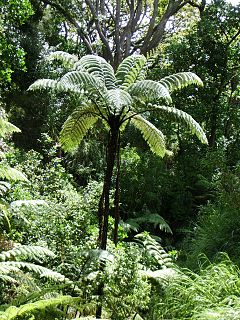Cyathea medullaris
| Black tree fern | |
|---|---|
 |
|
| Scientific classification | |
| Kingdom: | Plantae |
| Division: | Pteridophyta |
| Class: | Pteridopsida |
| Order: | Cyatheales |
| Family: | Cyatheaceae |
| Genus: | Cyathea |
| Subgenus: | Sphaeropteris |
| Section: | Sphaeropteris |
| Species: | C. medullaris |
| Binomial name | |
|
Cyathea medullaris (G.Forst) Sw., 1801 |
|
| Synonyms | |
|
|
Cyathea medullaris, popularly known as the black tree fern, is a large tree fern up to 20 m tall. It is distributed across the south-west Pacific from Fiji to Pitcairn and New Zealand. It is called mamaku, katātā, kōrau, or pītau in the Māori language.
C. medullaris is common in lowland forest throughout the North Island. In the South Island its distribution is more localised. It is fairly common in wetter coastal areas, but rare in the drier eastern parts and absent in Canterbury and Otago. In New Zealand it also occurs on the Three Kings Islands in the far north, on Stewart Island/Rakiura in the far south and in the Chatham Islands.
The other parts of its distribution include Fiji, the Marquesas Islands, Tahiti, and the Austral Islands and Pitcairn. It is not present in the Kermadecs.
The trunk is black and covered with hexagonal stipe bases. The fronds may be up to 5 m long, and arch upwards from the crown. Dead fronds are shed except in very young plants. The primary pinnae are from 40 cm to 1 m long, and the undersides bear scales with marginal spines. The stipes are thick, black, very rough to the touch, and covered in black scales with marginal spines. C. medullaris can be readily distinguished from related species by the hexagonal stipe scars on the trunk and by the scales with spines on their margins.
C. medullaris will grow from fresh spores, but this is slow. Plants are easy to transplant when they are young. It is also possible to plant newly felled trunks which will generally sprout again, provided they are watered with care. They are hardy in various conditions once established.
Tree fern trunks, including those of C. medullaris, have been used as rough building material and also for makeshift trackwork.
...
Wikipedia
